细胞内锌离子转运促进血管化骨再生的机制及调控策略研究
IF 18
1区 医学
Q1 ENGINEERING, BIOMEDICAL
引用次数: 0
摘要
骨再生是一个重大的临床挑战。骨损伤修复的主要障碍是局部血流障碍和缺氧微环境。间充质干细胞(MSC)治疗在促进骨组织再生方面具有显著的优势。在本研究中,我们建立了骨髓间充质干细胞(BMSCs)治疗小鼠颅骨损伤模型。我们发现,局部骨髓间充质干细胞移植刺激了血管化骨再生,基质金属蛋白酶(MMP)10是主要的调节蛋白。局部缺氧微环境诱导线粒体通透性增加,导致细胞质Zn2+积累,这是激活JAK1/STAT1/MMP-10通路的关键因素。胞质Zn2+富集引起的ZRT/ irt样蛋白6 (ZIP6)抑制是这一过程的关键启动因子。基于这些发现,我们设计和改造了含有吲哚菁绿(ICG)的外膜嵌合CD90抗体CD90@ZIF-8-ICG,通过靶向递送颗粒到局部MSCs中来增加细胞内锌离子含量,从而在愈合早期调节局部MMP-10的产生和血管生成。ICG为BMSCs提供连续的光热刺激以响应激光干预,成功地实现了骨缺损再生的稳定改善。本研究创新性地描述了细胞内锌离子稳态和ZIP蛋白在移植间充质干细胞功能中的调控重要性,以及相关效率策略的制定,阐明了间充质干细胞治疗的治疗机制,为干细胞基生物材料的设计和开发提供了策略。本文章由计算机程序翻译,如有差异,请以英文原文为准。

Mechanism and regulatory strategy study on promoting vascularized bone regeneration via intracellular zinc ion transport
Bone regeneration is a major clinical challenge. The main obstacles to bone injury repair are local blood flow disorders and hypoxic microenvironments. Mesenchymal stem cell (MSC) therapy has notable advantages in promoting bone-tissue regeneration. In this study, we established a mouse model of skull bone injury treated with bone marrow mesenchymal stem cells (BMSCs). We found that local BMSC transplantation stimulated vascularized bone regeneration and matrix metalloproteinase (MMP)10 was the major regulatory protein. Local hypoxic microenvironment-induced mitochondrial permeability increased, resulting in cytoplasmic Zn2+ accumulation, which is a key factor in activating the JAK1/STAT1/MMP-10 pathway. The cytoplasmic Zn2+ enrichment caused ZRT/IRT-like protein 6 (ZIP6) inhibition was the key initiating factor in this process. Based on these findings, we designed and engineered CD90@ZIF-8-ICG, with an outer membrane chimeric CD90 antibody containing indocyanine green (ICG), to achieve increased intracellular zinc ion content by targeted delivery of the particles into local MSCs, so that local MMP-10 production and angiogenesis are regulated at the early stage of healing. ICG provided BMSCs with continuous photothermal stimulation in response to the laser intervention, which successfully achieved stable improvement of bone-defect regeneration. This study innovatively describes the regulatory importance of intracellular zinc ion homeostasis and ZIP proteins in the function of transplanted MSCs, as well as the related efficiency strategy development, which elucidates MSC therapy treatment mechanisms and provides strategies for the design and development of stem-cell-based biomaterials.
求助全文
通过发布文献求助,成功后即可免费获取论文全文。
去求助
来源期刊

Bioactive Materials
Biochemistry, Genetics and Molecular Biology-Biotechnology
CiteScore
28.00
自引率
6.30%
发文量
436
审稿时长
20 days
期刊介绍:
Bioactive Materials is a peer-reviewed research publication that focuses on advancements in bioactive materials. The journal accepts research papers, reviews, and rapid communications in the field of next-generation biomaterials that interact with cells, tissues, and organs in various living organisms.
The primary goal of Bioactive Materials is to promote the science and engineering of biomaterials that exhibit adaptiveness to the biological environment. These materials are specifically designed to stimulate or direct appropriate cell and tissue responses or regulate interactions with microorganisms.
The journal covers a wide range of bioactive materials, including those that are engineered or designed in terms of their physical form (e.g. particulate, fiber), topology (e.g. porosity, surface roughness), or dimensions (ranging from macro to nano-scales). Contributions are sought from the following categories of bioactive materials:
Bioactive metals and alloys
Bioactive inorganics: ceramics, glasses, and carbon-based materials
Bioactive polymers and gels
Bioactive materials derived from natural sources
Bioactive composites
These materials find applications in human and veterinary medicine, such as implants, tissue engineering scaffolds, cell/drug/gene carriers, as well as imaging and sensing devices.
 求助内容:
求助内容: 应助结果提醒方式:
应助结果提醒方式:


